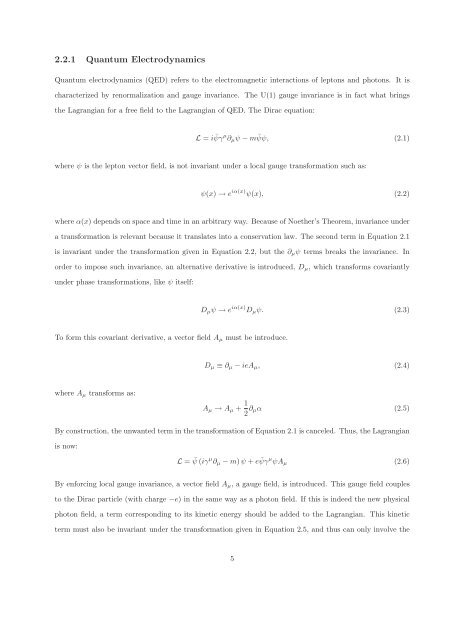CERN-THESIS-2012-153 26/07/2012 - CERN Document Server
CERN-THESIS-2012-153 26/07/2012 - CERN Document Server
CERN-THESIS-2012-153 26/07/2012 - CERN Document Server
You also want an ePaper? Increase the reach of your titles
YUMPU automatically turns print PDFs into web optimized ePapers that Google loves.
2.2.1 Quantum Electrodynamics<br />
Quantum electrodynamics (QED) refers to the electromagnetic interactions of leptons and photons. It is<br />
characterized by renormalization and gauge invariance. The U(1) gauge invariance is in fact what brings<br />
the Lagrangian for a free field to the Lagrangian of QED. The Dirac equation:<br />
L = i ¯ ψγ µ ∂µψ − m ¯ ψψ, (2.1)<br />
where ψ is the lepton vector field, is not invariant under a local gauge transformation such as:<br />
ψ(x) → e iα(x) ψ(x), (2.2)<br />
where α(x) depends on space and time in an arbitrary way. Because of Noether’s Theorem, invariance under<br />
a transformation is relevant because it translates into a conservation law. The second term in Equation 2.1<br />
is invariant under the transformation given in Equation 2.2, but the ∂µψ terms breaks the invariance. In<br />
order to impose such invariance, an alternative derivative is introduced, Dµ, which transforms covariantly<br />
under phase transformations, like ψ itself:<br />
To form this covariant derivative, a vector field Aµ must be introduce.<br />
where Aµ transforms as:<br />
Dµψ → e iα(x) Dµψ. (2.3)<br />
Dµ ≡ ∂µ − ieAµ, (2.4)<br />
Aµ → Aµ + 1<br />
2 ∂µα (2.5)<br />
By construction, the unwanted term in the transformation of Equation 2.1 is canceled. Thus, the Lagrangian<br />
is now:<br />
L = ¯ ψ (iγ µ ∂µ − m) ψ + e ¯ ψγ µ ψAµ<br />
By enforcing local gauge invariance, a vector field Aµ, a gauge field, is introduced. This gauge field couples<br />
to the Dirac particle (with charge −e) in the same way as a photon field. If this is indeed the new physical<br />
photon field, a term corresponding to its kinetic energy should be added to the Lagrangian. This kinetic<br />
term must also be invariant under the transformation given in Equation 2.5, and thus can only involve the<br />
5<br />
(2.6)















